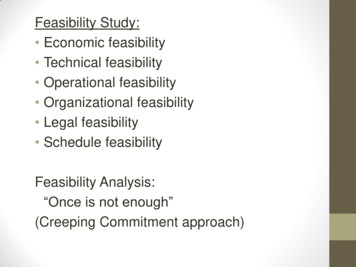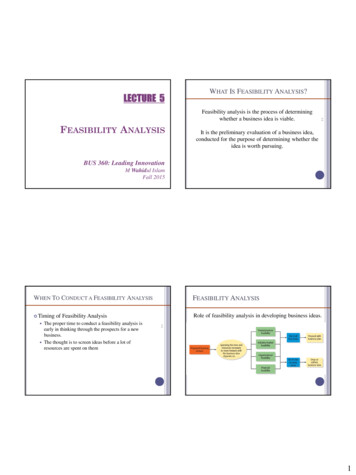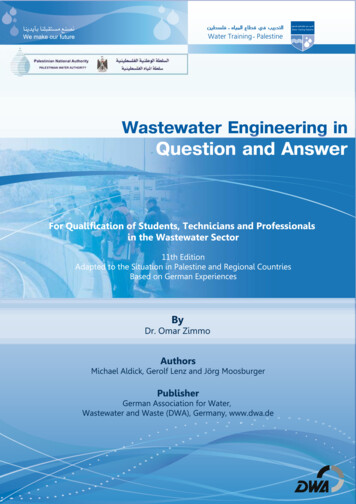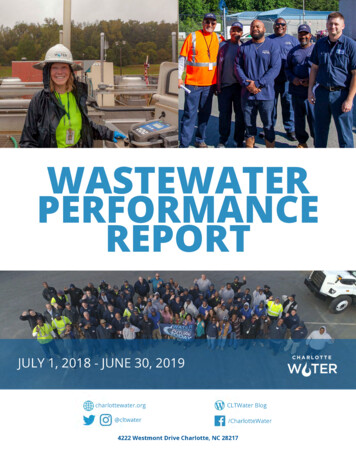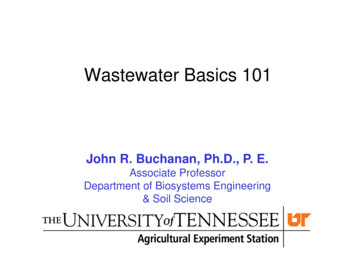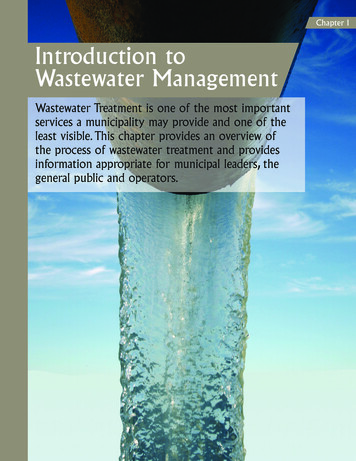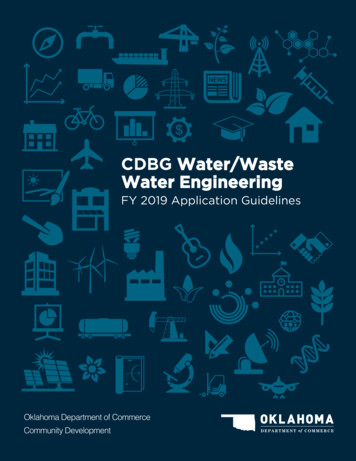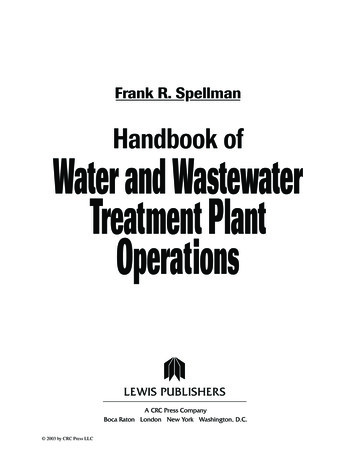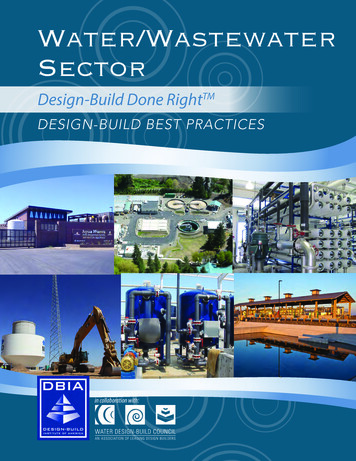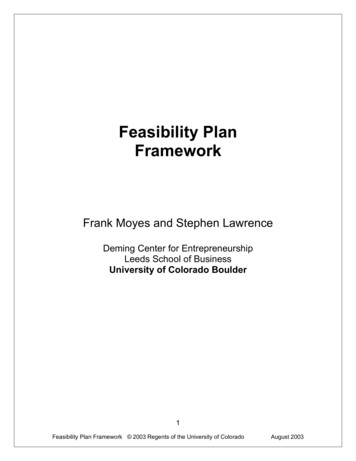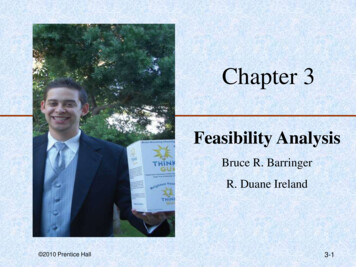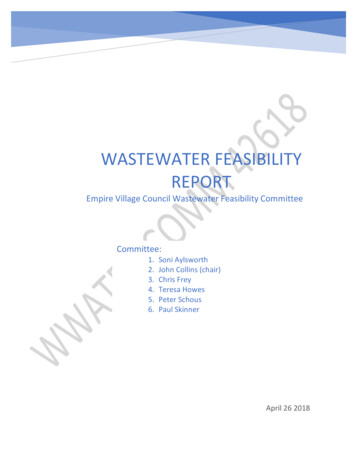
Transcription
6969WASTEWATER FEASIBILITYREPORTEmpire Village Council Wastewater Feasibility CommitteeCommittee:1.2.3.4.5.6.Soni AylsworthJohn Collins (chair)Chris FreyTeresa HowesPeter SchousPaul SkinnerApril 26 2018
Empire Wastewater Feasibility StudyTable of ContentsPagei.Executive Summary3ii.Introduction7iii.Empire Wastewater Practices and Regulations9iv.Wastewater Engineering Feasibility Study14v.Financial Analysis20vi.Needs Analysis23vii.Empire Moving Forward341
Committee Work AttachmentsAppendicesA. Gosling Czubak Engineering Report – Village of EmpireGosling Czubak Engineering Sciences, Traverse City MIB. Wastewater Scenarios Financial AnalysisMichigan Rural Community Assistance Program (MI-RCAP)C. Residential Septic System Regulations SummaryCommittee work analysis of State and County Septic RegulationsD. Commercial Septic Systems Regulations SummaryCommittee work analysis of State and County Septic RegulationsE. Commercial Business Septic Systems & Land Use – Empire SituationCommittee work analysis of State and County Septic RegulationsF. Empire Commercial/Residential (CR) Zoning – Business Type ListingCommittee work analysis of State and County Septic RegulationsG. Empire Commercial/Public Business List - Health Department Septic Records ReviewedCommittee work analysis of State and County Septic RegulationsH. Septic Age ProfileCommittee work compilation from County and Village Septic RecordsI. Wastewater System Study Area Scenario(s) MapsCommittee work with Leelanau County Equalization GIS ServiceJ. Village of Empire Groundwater Test Well MapCommittee work with Leelanau County Equalization GIS ServiceReference Attachments1. How Septic Systems tem-works2. Michigan Criteria Subsurface Discharge (septic systems)DEQ - Onsite q-wb-dwehs-osw-mcssd 241120 7.pdf3. Leelanau County Health Department Environmental Health leelacode.pdfhttp://www.bldhd.org/publications4. Village of Empire Point of Sale Septic OrdinanceVillage of Empire – Ordinance #1375. Village of Empire Water Usage DetailVillage of Empire Water Department6. Michigan Rural Community Assistance Program (MI-RCAP) BioMI-RCAP Website - http://michigan-rcap.org/7. Village of Empire Groundwater Testing Detail8. South Bar Lake Study, 2014Village of Empire DPWGreat Lakes Environmental Center (GLEC), Traverse City9. South Bar Lake Cooperative Lakes Monitoring DetailSouth Bar Lake Association Volunteers for Michigan Clean Water Corps, Cooperative Lakes Monitoring Program10. South Bar Lake & Lake Michigan Beach TestingSOS Analytical, Traverse City; in conjunction with the Leelanau/Benzie District Health Department11. Michigan State University Fecal Bacteria Study Across Michigan ge-out-of-rivers-and-lakes2
I.Executive SummaryThe Wastewater Feasibility Committee was formed by the Empire Village Council toobtain facts and compile information on the feasibility and need for Village wastewateroptions. The committee report addresses Empire Wastewater Practices and ExistingRegulations, a Wastewater Engineering Feasibility Study, Financial Analysis, NeedsAnalysis and Empire Moving Forward.Empire Wastewater Practices and Existing RegulationsWastewater in the Village of Empire is managed in accordance with existing state,county and village regulations and ordinances.Village wastewater permits were reviewed and a profile created for residential andcommercial permits and practices. Over 350 septic systems exist in the village with40% dating back earlier than 1990.Residential wastewater is typically handled by individual septic tanks and dischargefields. The new neighborhood utilizes a community collection and discharge field. Inthe core village, there are hundreds of septic systems in a concentrated area. Arelatively shallow water table and small lot sizes presents challenges and constraints.Commercial businesses utilize wastewater solutions largely septic system based. Mostexisting businesses are “grandfathered” utilizing systems that do not meet currentstandards. Regulations and small lot sizes prevent these ever meeting the current onsite standards. A few businesses are forced to “pump and haul” waste to off-sitetreatment facilities. Development of vacant property requires site-specific wastewatersolutions which can require additional land, costly treatment systems or limit potentialuses.The Village of Empire Point of Sale (POS) ordinance has resulted in corrective actionstaken for deficient systems. The Empire ordinance differs from other more stringentcommunity ordinances. There is no county POS ordinance.Wastewater Engineering Feasibility Study:An Engineering Feasibility study was conducted by Gosling Czubak Engineers (AppendixA). Three test case scenarios were developed for evaluation of costs and feasibility.The scenarios represented logical geographic service areas. Capital, and operations and3
maintenance costs for each scenario were estimated utilizing Empire water data (toproject wastewater quantities), village street layouts and infrastructure.Study findings are:A village wastewater system is technically feasible and can be implemented for theentire Village of Empire or for a smaller geographic area.There are alternatives for collection and treatment systems depending on the specificservice populations. Modular wastewater treatment systems are available that provideadvanced treatment and require relatively small discharge field areas of 1-2 acres.Capital costs of the test case scenarios ranged from 2-6M, with annual operations andmaintenance costs from 70-160K depending on the service area, collection andtreatment system chosen.Although the study was limited to three scenarios, there are numerous other potentialscenarios which could be developed based on geography, user requirements, wastecharacteristics and economic need.Financial AnalysisCapital and operating costs and wastewater quantities were converted to projectedmonthly user costs (Appendix B). The costs can be mitigated to an extent through theuse of USDA loan financing commonly utilized for such projects.For residential customers, the monthly bill would likely be much more than currentVillage water bills. For commercial customers, the costs would need to be incorporatedinto monthly operating budgets.Needs AnalysisThe need for a Village or partial wastewater system involves many factors andconsiderations. The community need for businesses, public services and employmentopportunities are a few of the many considerations beyond this report. The committeedid consider the environmental and economic need for a wastewater option.Environmental Need:There is no regulatory environmental need compelling a village wastewater system.Although many existing systems in the village do not meet current standards, they are“grandfathered” and operate in legal compliance.4
The core village area concentration of aging septic systems on relatively small lots overa shallow water table is a minimally acceptable environmental and regulatorycondition. It presents land use and environmental limitations going forward.The Village and local volunteers have supported commendable ongoing environmentalmonitoring initiatives. There is an opportunity to better integrate these efforts, updatepast studies and improve the overall knowledge of the Village environmentalinteractions and impacts. This effort should continue to be supported by the Villageand the community.A wastewater system, although not required, would provide environmental benefits ofenhanced treatment and discharge quality.Economic Need:Empire has a small number of year-round residents. However, it is host to the SleepingBear National Lakeshore Visitors Center and many of the 2 million annual park visitors.The commercial need is in the context of serving both Empire residents and visitors.There is an economic need for a wastewater system to maintain and support existingbusinesses and commercial development.Health Department records were examined on 35 parcels that make up Empire’scurrent business and public building base in the commercial/residential zoned area.The existing commercial district is restricted, in expanding services and accommodatinggrowth requiring increased water use, due to wastewater limitations.69% (24 parcels) are non-conforming with today’s septic regulations. These arerestricted in how they can change due to land area and wastewater dischargelimitations.31% (11 parcels) are conforming to the original building use, but are restricted inany expansion increasing wastewater discharge.A wastewater system would eliminate barriers to development currently imposed, notby zoning, but by wastewater requirements. A wastewater system would supportresidential and commercial property use consistent with Village planning and zoning.5
For undeveloped residential lots, a wastewater system would support areas withdifficult soils or proximity to groundwater. For existing residential lots with failingsystems, mounded solutions would not be needed.For commercial property, a wastewater system would facilitate new development.Small village commercial lots would be able to host more water intensive uses. Forexisting businesses, a wastewater system would eliminate the need for“grandfathered” exceptions and off site “pump and haul” practices. Existing businessescould expand services or change uses. Increased commercial use will increase theVillage tax base.Empire Moving ForwardDecisions about wastewater must take into consideration many factors in addition tothose considered by this committee. For this reason, the committee was tasked to notprovide a recommendation regarding implementing a wastewater system.Empire has a unique and special urban and natural environment. Protecting andpreserving this environment requires understanding the current conditions andmanaging change. Village government planning and zoning provides a blueprint forland use.Village infrastructure for water, gas, electricity, communications, and roads aremeeting needs and are, in many cases, excellent. There is no village infrastructure orservices for wastewater. A village or partial wastewater system is feasible, offersbenefits and presents financial challenges.The study considered three test case scenarios and financing structures typical withmunicipal systems. There are other service area scenarios and financial structures thatcould be considered to meet wastewater demands. Any successful approach willrequire a match of user requirements, enhanced environmental treatment systems,and sustainable affordable financing.Moving forward, the Village of Empire can take the following actions; Support continued planning and analysis of potential wastewater scenarios Understand and stay current on Village wastewater practices, impacts onthe environment, and residential and commercial properties Support continued environmental monitoring, integration of efforts andanalysis Be open to innovation and creative approaches6
II.IntroductionVillage of EmpireIncorporated in 1895, the Village of Empire is a small (pop 373) community on theshores of Lake Michigan in the southwest corner of Leelanau County. As theheadquarters community of the Sleeping Bear Dunes National Lake Shore, the village island locked on three sides by the Lake Michigan to the west and the national parkbordering its north and south. The core village area is platted on a traditional gridcontaining a pedestrian accessible small downtown with a market, restaurant, postoffice, bank, library, Lake Michigan Beach Park and more. Like many northern Michiganvillages, the economic health is heavily dependent upon seasonal tourism with nationalpark attendance approaching 2 million annual visitors.Wastewater Feasibility CommitteeThe Wastewater Feasibility Committee was formed by the Empire Village Council inMay 2016. A Work and Report Plan was approved in September 2016 by the VillageCouncil. This report presents the results of the committee work.Committee TaskingThe Committee tasking:i. Review Empire wastewater practices and existing regulationsii. Develop and execute a Wastewater Engineering Feasibility Study of thescope and costs of wastewater system options for the Village of Empire.iii. Consider the “need” for wastewater optionsCommittee Members1. Soni Aylsworth2. John Collins (chair)3. Chris Frey4. Teresa Howes5. Peter Schous6. Paul SkinnerProcessThe committee worked in an iterative and collaborative manner over 20 months. Thisincluded over a dozen committee meetings attended by members of the communityand meetings with county health department and governmental administrators. Anengineering consultant provided analysis on the feasibility and costs of differentwastewater treatment scenarios. A not-for-profit consultant provided an analysis of7
available financing approaches and translated the system capital and operating costsinto the projected monthly costs to system customers.The Committee’s initial meetings discussed the committee objectives and methods toaccomplish the work. It was agreed to look at the entire village and smaller, moreconcentrated service areas. To ensure the committee was in alignment with the VillageCouncil tasking, a document, titled “Wastewater Feasibility Study Committee, Workand Report Plan”, was developed. This outlined the committee tasking and waspresented and approved by the Empire Village Council on September 21, 2016. Thereport addresses Empire Wastewater Practices and Existing Regulations, theWastewater Engineering Feasibility Study, Financial Analysis, Needs Analysis andEmpire Moving Forward.The committee report presents facts and information for use by the village and thecommunity. It is intended to support further discussions and deliberations with up-todate useful information. The report also contains findings and suggestions, for thebenefit of the Village, on other issues uncovered during the study.ContributorsThe committee expresses appreciation for the support, advice and contributions ofEmpire village residents, members of the Empire community, the Village of EmpireCouncil and staff, the Benzie-Leelanau District Health Department, MichiganDepartment of Environmental Quality, U.S. Department of Agriculture, Gosling CzubakEngineers and the Michigan Rural Community Assistance Program (MI-RCAP).8
III. Empire Wastewater Practices and RegulationsEmpire Wastewater DisposalWastewater in the Village of Empire is managed in accordance with existing state,county and village regulations and ordinances (Appendix C, D, E).Site-Specific SystemsFor the treatment of residential and commercial wastewater and sewage, the village ofEmpire relies almost entirely on individual, property based “on-site” disposal. Thereare approximately 350 to 400 on-site disposal installations, primarily septic tanks anddischarge fields, throughout the village on individual lots. The New Neighborhood (NN)subdivision, started in the 2000’s, uses community drain fields for wastewater disposal.Each of the 60 parcels will have individual septic tanks from which effluent flows bygravity to one of four sets of tanks, and pumped to community drain fields permittedby the state DEQ. These installations are owned by four homeowner groups in the NNand are required by the village to be inspected annually.Businesses and residences with septic systems that do not meet current standards are“grandfathered”; however, they must be brought up to current standards if they arereplaced or if there is a change in use. Where on-site disposal is not possible, the“grandfathered” accommodation has in certain instances allowed holding tanks thatare pumped out and wastewater transported to a municipal wastewater plant fortreatment. This practice, commonly called “pump and haul”, is no longer allowed bythe state or county health department for a new use, or for expanding an existing use.Current regulations for businesses require reserve drain fields, which limits newbusiness and/or expansion of existing businesses on the smaller lots such as the 50 footlots that comprise the core of Empire Village. In some instances, these requirementscan be met through acquisition of additional adjoining property. In others, the onlysolution is to limit the size or kind of business so that it is not so water intensive (e.g.,take-out instead of dine-in food service). Current Alternative Treatment System (ATS)guidelines are limited to residential use and are not expected, by the healthdepartment, to be expanded to commercial use.System Age ProfileAs part of its work, the committee conducted an “age profile” of the existing septicsystems in village (Appendix H).9
This was done through a review of official records on file at both the Leelanau BenzieDistrict Health Department (LBDHD) and the Empire Village Office. While records donot exist for septic systems installed prior to the mid 1960’s, and are incomplete fromthe mid 1960’s through the mid-1970’s, relatively good information at the county levelexists for systems installed and/or inspected from the mid-1970’s onward.The records were then compared to the Village tax parcels file. Out of 521 parcels ofrecord in the village, 350 are noted as improved with structures. The result is anestimated septic system age profile with 40% dating back earlier than 1990.Age ProfileDecade1970s & Earlier1980s1990s2000s2010sTotalSeptic Installations96465511340350Empire Septic Systems Age ProfileHealth Dept Records Review350 Village Tax Parcels with Structures, 279 w/ Health Dept Septic Records12%27%1970s and Earlier (No Health Dept septic recordson 71 systems)1980's permits, 28 to 37 yrs age systems1990's permits, 18 to 27 yrs age systems32%13%16%2000's permits, 8 to 17 yrs age systems2010's permits, 7 yrs or less age systems 40% estimated 28 yrs or more age systems.10
Wastewater Regulatory SituationStandards, regulations and permitting of on-site wastewater disposal installations bythe state and county health departments became more restrictive in the mid 70’s. Themost commonly used on-site disposal method, in the village, is a “septic system”. Thisis comprised of a septic tank which collects wastewater, retains “solids” and dischargeseffluent into a drain field spread horizontally near the ground surface that “leeches”wastewater into the soil for biodegradation. Prior to this period, there was limitedregulation and sewage disposal methods varied widely from early septic system designsto drywells to pipes in the ground or on the surface.Wastewater disposal in Empire is currently governed by three regulations at the state,county, and local levels: 1) Michigan Criteria for Subsurface Sewage Disposal(Reference 2); 2) Environmental Health Regulations for Leelanau County HealthDepartment (Reference 3); and 3) Village of Empire Ordinance 137, Point of SaleOrdinance (Reference 4). The State of Michigan criteria for regulating subsurfacesewage disposal “provide minimum uniform standards of design and construction forsuch systems in Michigan. Nothing in these criteria shall prevent local healthdepartments or other government agencies from adopting and enforcing requirementsmore stringent than these requirements.” (Michigan Criteria for Subsurface SewageDisposal, p. 1).In Michigan, state law and county health department codes work in tandem. Theyjointly dictate the design, sizes and siting of permissible on-site installations. Per statelaw, permitting of new or replacement systems is for the most part the purview of thecounty health department.In Empire, all on-site septic systems since permitting started, have been permitted bythe LBDHD, or jointly by the LBDHD/State. The permitting process involves determiningthe adequacy of the property soil for drainage as well as the proximity of ground waterto the surface. A key requirement is that there be four feet of undisturbed soil aboveindications of high sub-surface ground water. Permits specify the size and placementof tanks and drain fields, as well as any pumping required for a drain field. Drain fieldsize varies by the use of the property and new commercial use permitting requires areserve area, equivalent to the drain field size, set aside on which there can be nodevelopment.At larger wastewater volumes and in any municipal systems, county healthdepartments cease to be primarily involved and responsibility shifts to the MichiganDepartment of Environmental Quality (MDEQ). With MDEQ regulations, there is a11
range of requirements governing both permitting, construction, operation monitoring,testing, and mandated reporting. For the vast majority of on-site sewage disposalinstallations in Empire, the county health department (and indirectly the state) is thepermitting agency for new or replacement systems.For Empire’s typical residential and smaller commercial on-site wastewater volumes,the State of Michigan does not have requirements for periodic system monitoring,inspection, or maintenance after the initial permit and construction. The LeelanauCounty health code has no “post installation” requirements as well. The thinkingbehind this is that septic systems built to current standards are very passive inoperation, self-regulatory and when failure occurs, it is very noticeableReference 1 contains a brief description of how modern septic systems work.There are key local factors that affect how septic systems work in Empire: Empire’s soil is predominantly sand. This allows for excellent percolationflow, but can also flow too quickly relative to water table levels. The nutrient phosphorous in wastewater is removed chemically throughsoil bonding during percolation. Sand is a less than ideal soil type forphosphorus soil bonding. Parts of Empire have a high water table. Test wells placed around the corevillage indicate near surface static ground water at five to eleven feet ofdepth depending on year and season. The LBDHD has found high waterindications at sometimes four feet or less.Failure of septic systems involves failure of septic tank effluent percolation or failure ofsufficient cleansing before reaching the groundwater (appendix Reference 1).Percolation failure can be noticed in the form of pooling sewage on the ground surfaceor backed up sewage in the septic tank or in the building. Failure of proper effluentcleansing can go unnoticed even as effluent still passes into the groundwater. Theseptic system may be old and not built to current standards. Older systems may use“dry wells” which concentrate the discharge and treatment area instead of drain fieldsdispersing effluent over a larger area. Soil conditions may have degraded in spite ofdrainage continuing. Drainage may be overly concentrated in an area instead ofspreading out. Drainage may be too fast. The groundwater may be too close relativeto drainage speed and conditions. In these cases, wastewater reaches groundwaterbefore effective self-cleansing of bacteriological and chemical (nitrogen, phosphorus,etc.) contaminants.12
Empire POS OrdinanceOn May 28, 2013, the Village of Empire enacted a point of sale ordinance (Ordinance#137) requiring all septic systems be inspected at the point of sale (POS). Theinspection is required to be scheduled by the seller and to be performed by either theLBDHD or a licensed NSF sanitarian. For the inspection, the ordinance is specific onwhat constitutes a system failure:Sewage backup in a structureGround surface sewage dischargeA storm drain connectionBacked up septic tank liquidA structurally damaged septic tankSewage discharge into a body of waterIf failure by the above criteria is determined, a new or conforming system is requiredthrough LBDHD permitting. Since the ordinance, approximately thirty POS inspectionsin Empire have taken place with corrective actions and findings.Eight property septic system replacements took place associated with inspections orprior to a sale. In no instance did an inspection indicate actual failure. Two systems were deemed operational but inadequate and the owners acted tocorrect the issue. One system passed inspection but backed up later and was replaced. One commercial property sold involved an LBDHD inspection which foundinadequacy for a proposed use. Three systems were replaced preemptively by sellers without inspections. One system was replaced under a previous, stricter village POS ordinance.The failure definitions in the Empire ordinance would be deemed a public health issueby the county health department with or without the ordinance. Empire’s sandy soilsand relatively high-water table can allow for a deficient septic system to behydraulically draining but not providing the soil contact time needed for sufficientbiological treatment. A Glen Arbor Township ordinance and a Benzie County ordinancedo not focus on noticeable failure but have a more stringent “code based” standardconsidering property septic system design, placement and adequacy for performancebased on building size, use and critically, proximity to groundwater.Currently there is no county POS ordinance, although discussions are continuing on thisissue.13
IV. Wastewater Engineering Feasibility StudyScope of WorkGosling Czubak Engineering was contracted by the Village of Empire to perform anengineering study of the costs and feasibility of a village wastewater system. TheGosling Czubak report is included as Appendix A. Detailed information on theassumptions, data, and cost calculations can be found in the complete report.Study ScenariosThree geographic scenarios were structured by the committee and Gosling Czubak.This case study provides examples of different size and geographic service areas. Thesescenarios were structured for study purposes to provide preliminary engineeringapproaches and cost estimates utilizing actual Empire street layouts, servicepopulations and wastewater flows.The three study scenarios are defined in the following description as well as separatemaps in Appendix I.14
15
4.1DescriptionThe three scenarios are as follows:Scenario 1: Village Wide Does not include areas not served by the village water system. Does not include areas already served by industrial or community treatment system.Scenario 2: Village Commercial Zone Includes areas designated by the zoning map as consisting of commercial residential district. Includes the National Park Station headquarters off of M-72 Includes St. Phillip Neri to the NorthScenario 3: Commercial and Central Village Includes the areas designated by the zoning map as consisting of commercial residential districtand the village residential. Includes the National Park Station headquarters off of M-72 Includes St. Phillip Neri to the NorthWastewater Feasibility StudyMay 24, 2017The following table summarizes the design flow and number of customers for each scenario.Preliminary Engineering ReportPage 6Table 1: Village of Empire 2017 Wastewater Feasibility StudyResidential UnitsNon-residential UnitsFlow SummariesAverage Day (gallons)Max Day (gallons)Scenario 128928Scenario 24625Scenario 31492535,50055,00010,50016,50019,00028,000Note:The “units”in the abovetablearecollectionEmpire ebillingFor eachof the scenarioslisted,bothand treatmentalternativeswereclassification. More detailed of the water usage can be found in Reference 5.treatment alternatives were as follows: Aerated lagoon with spray irrigation or Decentralizedtreatment plant. Lagoon treatment for scenario’s 2 and 3 were initially considered but found notto be feasible due to the small number of users that would be contributing to the capital cost.For the collection system, a traditional gravity system and a septic tank effluent (STEP) systemwere evaluated. The gravity collection system consists of gravity sanitary sewer in the collectionareas with a pump station and force main to convey the wastewater to the treatment location. Thepump station location was assumed based on general topography as well as Village owned propertylocations. Adjustments to this assumption could increase the required number of pump stationsand overall capital cost.The STEP system consists of on-site watertight septic tanks at every connection. The septic tank16
Collection, Treatment and DischargeFor the scenarios, collection and treatment alternatives were considered.The treatment alternatives evaluated were aerated lagoons with spray irrigation or amodular decentralized treatment plant. Lagoon treatment wasfound not feasible for scenario 2 and 3 due to the smaller user base and higher capitalcost. Lagoon treatment requires significant land area and associated collectiontransport costs. A Decentralized treatment plant was evaluated for all three scenarios.A decentralized treatment plant provides a high degree of environmental treatmentand protection of the environment. It is modular, can sited lo limited land and isscalable for changing demands and growth. It also requires a limited land area for finaleffluent groundwater discharge. The land area needed for these plants can often bethe size of several “shipping containers”, mostly buried and with little visual intrusion.For collecting the wastewater (collection system) and transporting it to the treatmentplant two approaches are considered: a traditional gravity system and a Septic TankEffluent Pressure System (STEP).The gravity system consists of gravity flow in the collector sewers with a pump station,pumping sewage through a force main to the treatment location.The pump station location was assumed based on topography and Village ownedproperty locations.The STEP system consists of watertight septic tanks at each collection residence orbusiness. The septic tank provides primary settling and septic tank effluent is pumpedby a low power
Review Empire wastewater practices and existing regulations ii. Develop and execute a Wastewater Engineering Feasibility Study of the scope and costs of wastewater system options for the Village of Empire. iii. Consider the “need” for wastewater options Committee Members 1. Soni Aylsworth
